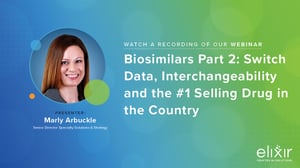Specialty medications continue to be a large source of drug spend, in particular biologic drugs. Biosimilars pose an opportunity to offer significant savings, if they can get to market and gain acceptance. At the end of last year, Elixir published a blog post on Biosimilar Basics, explaining the difference between traditional generics and biosimilars, as well as hosted a webinar discussing the differences between Biologics, Biosimilars and Interchangeable Products. On August 4, we continued this educational series with a webinar on Switch Data, Interchangeability and the #1 Selling Drug in the Country, Humira®. If you missed the webinar, here’s what it covered:
Defining Biosimilars and Interchangeability
Biosimilar drugs are biological products that are highly similar and have no clinically meaningful difference from an existing FDA-approved reference or originator biologic product. Unlike traditional generics, a biosimilar product that does not have interchangeability status cannot be substituted for the original biologic at the pharmacy without getting a new prescription, even if the doctor indicates substitutions are permitted.[1]
An interchangeable is a biosimilar that meets additional FDA requirements demonstrating it should produce the same clinical results as the reference product (RP) and that there are no safety or efficacy risks when alternating between the RP and the biosimilar. Interchangeability status allows the biosimilar to be substituted at the pharmacy without a new prescription, if state law allows.[1]
State substitution laws are overseen by each state’s pharmacy board. Today, most states allow for substitutions with an interchangeable product (only Washington, Indiana, South Carolina and Alabama do not allow for substitution without intervention from the healthcare provider), and some have caveats, such as the substituted products must result in a lower cost for the patient.[2]
Biosimilars do not need to be interchangeable to be FDA approved. Only three biosimilars have interchangeability status today (Semglee®, Cyltezo® and Cimerli™), but that lack of interchangeability could be one of the barriers to biosimilars utilization. In 2020, biosimilars only captured 30% of the market where they were competing.[3] Other factors contributing to this low acceptance rates are a perceived lack of efficacy caused by fear of the unknown, patent litigation that has slowed entrance into the market, and billing and supply chain procurement discrepancies. Additionally, the originator product’s direct marketing efforts to the consumers and providers, or brand loyalty, can be a barrier.
Is There Value in Interchangeability?
As part of the FDA’s regulatory process for interchangeability, switch studies need to be performed to determine that there are not additional safety or efficacy risks when alternating between the RP and the biosimilar. While interchangeability status could help to overcome some of the barriers to biosimilar acceptance, seeking interchangeability status increases the costs and time to market for a manufacturer. Therefore, manufacturers need to weigh the risks and benefits of seeking interchangeability status, particularly since interchangeability is not an issue in other countries.
The European Union (EU) does not distinguish between biosimilars and interchangeability status and does not require additional switch studies. Their view is that the studies used to bring a biosimilar to market should be adequate and that the switch studies required by the U.S. for interchangeability status are actually inadequate at showing that a biologic substitution doesn’t impose an increased risk. What they believe is needed are larger, post-marketing surveillance and follow up. Instead of switch studies, they defer to the individual countries in the EU and allow prescribers to dictate interchangeability and when to substitute. Most European countries do not allow substitution at the pharmacy level without the involvement of the prescriber.[4], [5], [6]
While it’s debatable whether switch studies add value, what interchangeability does add is an increase in clinical confidence, as it’s perceived as being okay to switch. It also helps with operational efficiencies at the pharmacy level and can assist patients who are uninsured or underinsured because they can more easily switch to the lower costing drug.
The Impact of Humira Biosimilars
The first biosimilars for Humira, the number one selling drug in the country, were approved in 2016 and are anticipated to launch in the U.S. next year. According to a study published in the American Journal of Managed Care, the total potential savings from biosimilars in the U.S. from 2021 to 2025 are estimated to be over $38 billion and the Humira biosimilars are predicted to be just over half of that savings, at $19.5 billion. This is from both utilization of the lower costing biosimilars and a potential decrease in Humira utilization and costs.[7]
Today, there are 12 Humira biosimilars in the pipeline. Most of them are biosimilars for the original formulation of Humira, which is at a lower concentration of 50 mg/mL. Their approval left questions about the potential uptake because 80% of Humira utilizers are taking the newer, higher concentration, citrate-free formulations and would have to switch back to a lower concentration that they stopped taking years ago.[8]
As of March 2022, however, four higher concentration, citrate-free formulations (100 mg/mL) were approved. This means less stinging, burning and irritation upon injection. The higher concentration formulation could offer a better patient experience and provide less of a hurdle for conversion to biosimilars. Additionally, most of the high-concentration Humira biosimilars are also seeking interchangeability status. The hope is that this could lead to clinically viable, patient-centric, lower-costing options that would provide more competition in the marketplace and lead to significant savings for all stakeholders involved.
Tapping into the $19.5 Billion Potential Savings
With the Humira biosimilar products yet to launch and price points unknown, it is still too early to have a definitive strategy for tapping into the potential $19.5 billion these drugs could bring. However, there are discussions that should be started to plan ahead:
- Rollout Plan – Assess the landscape, including the number and type of utilizers (lower or higher concentration), the biologic products and timeframe for launch.
- Strategic Trade Agreements – Have the necessary contracting discussions with manufacturers, including rebate bundling, discounts and product availability.
- Formulary and Utilization Management – Look at formulary status, such as preferred product placement and coverage criteria updates, as well as utilization management criteria.
- Plan Design and Channel Strategy – Consider member cost share and potentially get creative with plan design, keeping in mind that some states require the biosimilar to be the lowest cost drug. Strategic involvement with the specialty pharmacy for collaboration is also helpful.
- Education – It is extremely important to continue to educate both members and providers on biosimilars in order to gain support and create clinical confidence in the market.
Elixir has begun these discussions and planning sessions to help our clients capitalize on the significant savings potential.
[1] FDA. Biosimilar Regulatory Policy: Understanding the Landscape and Relevance to Medical Practice. https://www.fda.gov/media/112814/download.
[2] Cardinal Health Biosimilar Interchangeability Laws. https://www.cardinalhealth.com/content/dam/corp/web/documents/publication/Cardinal-Health-Biosimilar-Interchangeability-Laws-by-State.pdf.
[3] Blank, C (2021). US Saved $338 Billion via Biosimilars and Generics. Managed Healthcare Executive. September 21, 2021. https://www.managedhealthcareexecutive.com/view/u-s-saved-338-billion-via-biosimilars-and-generics.
[4] Kvien, TK, Patel, K (2022). The cost savings of biosimilars can help increase patient access and lift the financial burden of health care systems. Seminars in Arthritis and Rheumatism. Volume 52, February 2022. https://www.sciencedirect.com/science/article/pii/S0049017221002171">https://www.sciencedirect.com/science/article/pii/S0049017221002171.
[5] Ebbers H, Schellekens H. Are we ready to close the discussion on the interchangeability of biosimilars? Drug Discovery Today. Volume 24, No 10. October 2019. https://reader.elsevier.com/reader/sd/pii/S1359644619301412?token=357EFD57FABEF35B04784947F60A1FAE0C903DCC89A91F902959C50F759E6FCD3CAEF0C00608B0FF190E2E8F29F7E537&originRegion=us-east-1&originCreation=20220715192008.
[6] Druedahl l, Sporrong SK, et al. Interchangeability of biosimilars: A Study of expert views and visions regarding the science and substitution. https://journals.plos.org/plosone/article?id=10.1371/journal.pone.0262537">https://journals.plos.org/plosone/article?id=10.1371/journal.pone.0262537.
[7] Mulcahy A, Buttorff C, et al. Projected US Savings From Biosimilars, 2021 – 2025. The American Journal of Managed Care, July 2022, Volume 28. Issue 7. https://www.ajmc.com/view/projected-us-savings-from-biosimilars-2021-2025">https://www.ajmc.com/view/projected-us-savings-from-biosimilars-2021-2025.
[8] IPD Analytics RxBrief. Settlement Agreement May Allow July 2023 Launch of High-Concentration Humira Biosimilars. March 2022.


